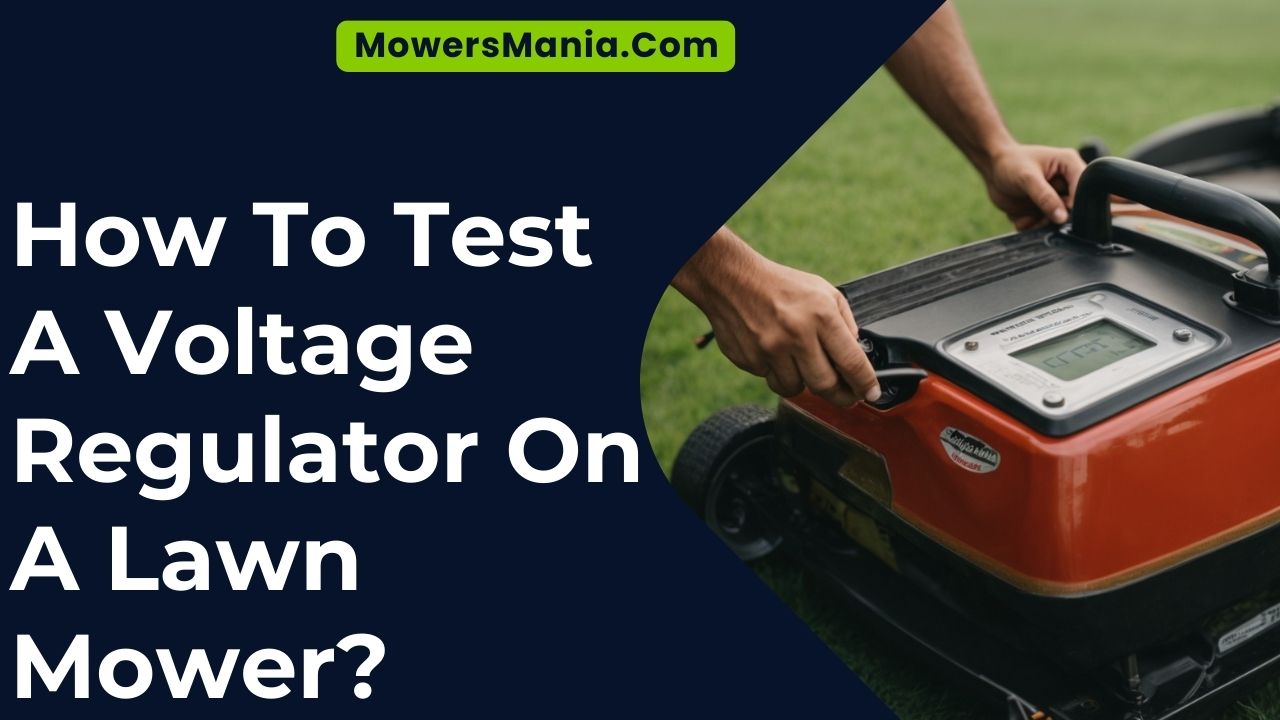In this guide, you’ll learn how to test a voltage regulator on your lawn mower. It’s important to ensure your mower’s electrical system is working properly for optimal performance.
By following these steps, you can easily check the voltage output of the regulator and identify any potential issues.

Remember to prioritize safety and gather the necessary tools before starting the testing process.
Let’s get started!
Safety Precautions
To ensure your safety while testing a voltage regulator on a lawn mower, follow these necessary precautions.
- First and foremost, make sure the lawn mower is turned off and the engine is cool before you begin any testing. This will prevent any accidental starts or burns.
- Next, wear appropriate protective gear such as safety glasses and gloves to shield yourself from any potential hazards.
- It’s also important to work in a well-ventilated area to avoid inhaling any fumes that may be emitted during the testing process.
- Additionally, keep a fire extinguisher nearby in case of any unexpected electrical malfunctions that could lead to a fire.
- When handling any electrical components, be sure to disconnect the battery and remove any metal jewelry to prevent the risk of electrical shock.
- Finally, follow the manufacturer’s instructions and use the correct tools for testing the voltage regulator.
Tools and Materials Needed
To properly test a voltage regulator on a lawn mower, you’ll need a few essential tools and materials. These items are necessary to ensure an accurate and successful testing process.
The first tool you’ll need is a multimeter. This device is used to measure voltage, current, and resistance. It will help you determine if the voltage regulator is functioning properly.
Additionally, you’ll need a pair of safety gloves to protect your hands from any potential electrical shocks. Safety goggles are also necessary to shield your eyes from any debris or sparks that may occur during the testing process.
In terms of materials, you’ll need a clean and well-lit workspace. This will allow you to work efficiently and safely. It’s also recommended to have a pen and paper handy to record any measurements or observations during the testing.
Lastly, you may want to have a replacement voltage regulator on hand in case the current one is found to be faulty. By having these tools and materials ready, you’ll be well-equipped to test the voltage regulator on your lawn mower effectively.
How To Test The Voltage Regulator On A Lawn mower: Step By Step

Step 1: Disconnect the Battery
To begin testing the voltage regulator on your lawn mower, the first step is to disconnect the battery. This step is crucial for your safety and to prevent any electrical accidents.
Start by locating the battery on your lawn mower. It’s usually located under the seat or on the side of the mower. Once you have located the battery, use a wrench or a socket set to remove the negative (-) terminal from the battery. Ensure that you’re disconnecting the negative terminal first as this will break the circuit and prevent any electrical flow.
Once the negative terminal is disconnected, move on to removing the positive (+) terminal in the same manner. Make sure to keep the terminals away from any metal surfaces to prevent accidental contact and electrical discharge.
After both terminals have been disconnected, secure them away from the battery to avoid any accidental reconnection.
Now that the battery is disconnected, you can proceed with testing the voltage regulator on your lawn mower.
Step 2: Locate the Voltage Regulator
Now, you’ll need to locate the voltage regulator on your lawn mower. The voltage regulator is a small device responsible for regulating the electrical output of your lawn mower’s charging system.
It’s usually located near the engine or on the side of the mower, but the exact location can vary depending on the make and model of your lawn mower.
To begin, you should consult your lawn mower’s owner’s manual for specific instructions on where the voltage regulator is located.
If you don’t have the manual or can’t find the information, you can try visually inspecting the engine and surrounding areas for a small rectangular or square-shaped component with wires attached to it.
In some cases, the voltage regulator may be mounted on the engine itself, while in others it may be attached to the frame of the lawn mower.
It’s important to note that some lawn mowers may not have a separate voltage regulator and instead rely on the charging system built into the engine.
Once you have located the voltage regulator, take note of its position and how it’s attached to the mower. This will make it easier when it comes time to test the voltage regulator in the next steps.
Step 3: Test the Voltage Output
To test the voltage output of the voltage regulator on your lawn mower, you’ll need a multimeter. This handy tool measures electrical current, voltage, and resistance. Before starting the test, make sure the mower is turned off and the key is removed from the ignition to avoid any accidents or injuries.
To begin, locate the voltage regulator on your lawn mower. It’s typically found near the engine or on the side of the mower. Once you have found it, identify the two terminals labeled ‘BAT’ or ‘B+’. These terminals are where you’ll be connecting the multimeter probes.
Set your multimeter to the DC voltage setting and ensure it’s set to a range that can handle the voltage output of your mower. Then, take the red probe and connect it to the terminal marked ‘BAT’ or ‘B+’. Next, take the black probe and connect it to a grounding point on your mower, such as the negative battery terminal or a metal part of the engine.
With the probes securely connected, turn on the multimeter and start the mower. Observe the voltage reading on the meter. A properly functioning voltage regulator should output a voltage within the manufacturer’s specifications, typically around 13-14 volts for a 12-volt system.
If the voltage reading is significantly higher or lower than the recommended range, it may indicate a faulty voltage regulator that needs to be replaced. Additionally, if the voltage reading fluctuates or is unstable, it could also indicate a problem with the regulator.

Frequently Asked Questions [FAQs]
How Often Should I Test the Voltage Regulator on My Lawn Mower?
You should test the voltage regulator on your lawn mower regularly to ensure it is functioning properly. This will help avoid any electrical issues and prolong the life of your mower’s battery.
Can I Use Any Type of Multimeter to Test the Voltage Output?
Yes, you can use any type of multimeter to test the voltage output of a lawn mower’s voltage regulator. Just make sure it is set to the appropriate voltage range and follow the testing procedure.
What Are the Signs That Indicate a Faulty Voltage Regulator on a Lawn Mower?
If your lawn mower’s voltage regulator is faulty, you may notice signs like inconsistent battery charging, dimming headlights, or the battery constantly dying. It’s important to test the regulator to confirm the issue.
Are There Any Specific Safety Precautions I Need to Take When Testing the Voltage Regulator?
When testing the voltage regulator on your lawn mower, it’s important to take specific safety precautions. Make sure to disconnect the battery and wear protective gloves and eyewear to avoid any potential accidents.
How Can I Determine if the Voltage Regulator Needs to Be Replaced or if It Can Be Repaired?
To determine if the voltage regulator needs replacing or repairing, start by testing its output voltage with a multimeter. If the reading is outside the acceptable range, replacement is necessary.
Conclusion
In conclusion, testing a voltage regulator on a lawn mower is a simple process that can help diagnose any issues with the electrical system. By following the steps outlined in this article and taking the necessary safety precautions, you can determine if the voltage regulator is functioning properly.
Remember to always disconnect the battery before testing, locate the voltage regulator, and test the voltage output.
This will ensure that your lawn mower’s electrical system is working efficiently.



